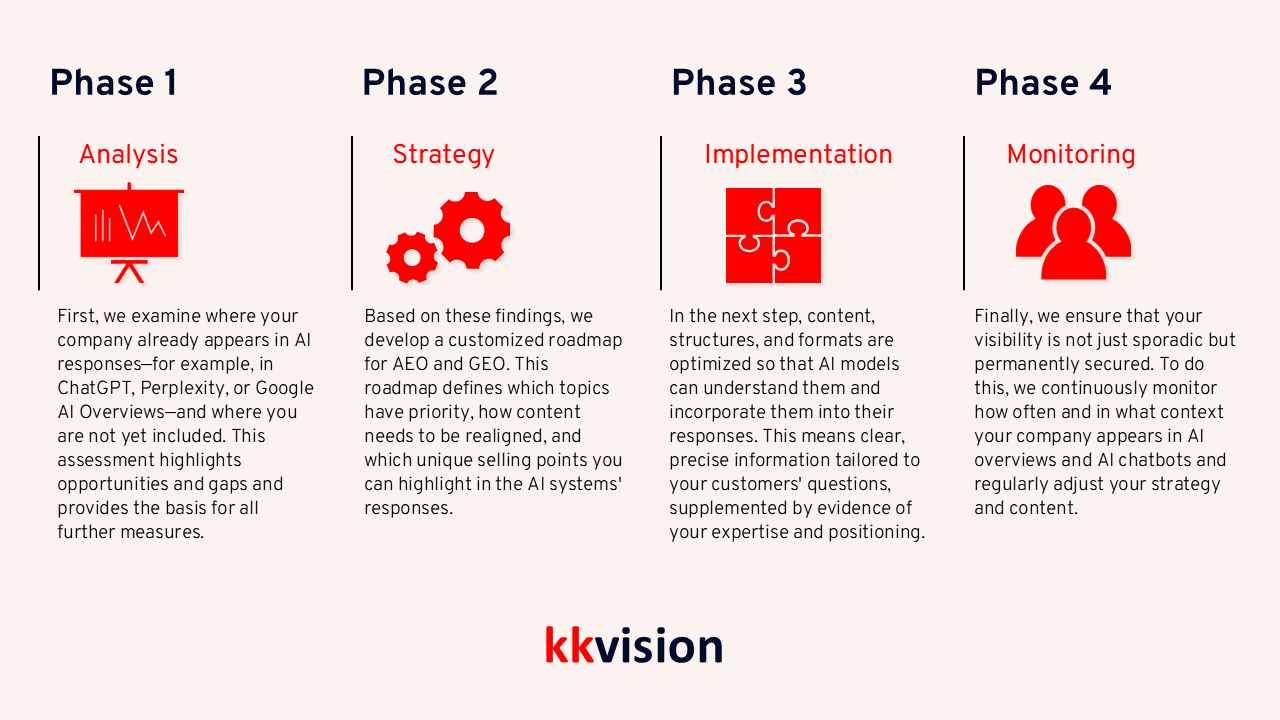
Author
Sebastian Küstermann
CCO
Table of contents
Share this article now!
DE
EN
DE
EN

Author
CCO
How to ensure that your company gets and stays visible in the answers provided by ChatGPT, Perplexity, and Google AI.
The most important facts
SEO on its own is no longer enough – AI systems such as ChatGPT and Google AI determine which content is visible.
Answer Engine Optimization (AEO) is essential for being present in AI responses.
Early adopters secure reach and competitive advantages, as AI prefers to use established sources.
For over two decades, SEO was the main instrument for ensuring visibility on the internet. Companies that made it onto the first page of Google for relevant keywords enjoyed continuous website traffic, leads, and sales.
This worked well for a long time. Marketing departments invested budgets in classic search engine optimization—in keyword research, backlink building, technical optimizations, and content strategies. The focus was on ranking in the top 3 on Google. That's where users decided which search results to pay attention to and which ones to trust.
But the rules of the game are currently undergoing radical change. More and more people are bypassing traditional Google searches and heading straight for AI-based systems such as ChatGPT, Perplexity, or Microsoft Copilot. Instead of clicking through a list of ten blue links, they expect an immediate, precise, and understandable answer—directly in the chat window or search interface.
The consequence: SEO on its own is no longer enough to remain visible.
Even a top ranking on Google no longer guarantees reach if users get their answers directly from ChatGPT, Perplexity, or Google's AI Overviews. The classic click logic is increasingly being replaced by a new paradigm: instead of search results pages, customers find information and providers via AI-generated answers.
Those who want to remain visible in this environment must adapt their strategy—and use Answer Engine Optimization (AEO) to ensure that their content appears directly in the responses provided by AI systems.
The new search reality also requires new terminology. While SEO was considered a key discipline for many years, concepts such as Answer Engine Optimization (AEO), Generative Engine Optimization (GEO), and AI Visibility Optimization (AIVO) are now crucial. They describe how content is prepared so that it not only ranks on Google, but also appears directly in the answers provided by AI systems.
AEO ensures that content from AI search systems such as ChatGPT, Perplexity, or Google AI Overviews is recognized and displayed directly as a response. The idea is to answer questions so clearly and comprehensively that the AI selects them as a relevant part of its output.
GEO goes one step further: The focus here is on generative AI models using a company as a reliable source. Content must be designed in such a way that it not only provides short answers, but is also suitable for longer, context-rich AI outputs.
Companies that continue to focus primarily on traditional SEO risk losing relevance in the new search landscape. The potential consequences are numerous:
GEO is the logical next step in the evolution of AEO. While AEO is about being present in the direct responses of systems such as Google AI Overviews or Perplexity, GEO aims to get generative AI models to include a company as a source in their output.
The key difference: AEO ensures visibility in specific response snippets, while GEO goes deeper and influences the content that is processed and recombined by large language models (LLMs) themselves. With GEO, visibility is created where users no longer search, but instead receive direct answers—often including recommendations or suggested solutions.
GEO's goal is clear:
Decision-makers do not need to know the technical details—the key is to understand which measures now take priority in order to ensure visibility in AI response systems. The following best practices form the core of a successful AEO strategy:
Taken together, this means that best practices in AEO are not just a list of measures, but a strategic approach to keeping companies visible at a time when traditional search mechanisms are increasingly being replaced by AI.
Companies that embrace AEO early on secure a decisive competitive advantage. Because as user behavior changes, so do the rules of visibility on the internet—those who act now will reap double the benefits.
More and more people expect direct answers that are provided without detours. Traditional results lists are losing importance, while perception and trust arise directly from the answers. Companies that do not appear here run the risk of gradually losing relevance—even if they are still well positioned in Google rankings.
Those who embrace AEO early on have a decisive advantage. Those who manage to become embedded in the sources of AI systems benefit from the fact that these systems prefer to reuse familiar sources. This creates lasting visibility. Content shapes concepts, arguments, and thought patterns that are adopted by AI systems. As a result, a company sets standards in its industry and builds trust—both with AI models and with users.
From an economic perspective, it is also worthwhile to get started quickly. Those who start late will have to invest significantly more to compete with established competitors. Early AEO signals—concise answers, consistent content, and proven expertise—have a long-term effect. They work like compound interest: visibility builds up continuously and strengthens without the need for a constant new budget.
kkvision.de offers companies a clear roadmap for systematically building and securing visibility in the new world of AI search systems. This roadmap comprises four consecutive steps:
First, we examine where your company already appears in AI responses—for example, in ChatGPT, Perplexity, or Google AI Overviews—and where you are not yet included. This assessment highlights opportunities and gaps and provides the basis for all further measures.
Based on these findings, we develop a customized roadmap for AEO and GEO. This roadmap defines which topics have priority, how content needs to be realigned, and which unique selling points you can highlight in the AI systems' responses.
In the next step, content, structures, and formats are optimized so that AI models can understand them and incorporate them into their responses. This means clear, precise information tailored to your customers' questions, supplemented by evidence of your expertise and positioning.
Finally, we ensure that your visibility is not just sporadic, but permanently secured. To do this, we continuously monitor how often and in what context your company appears in AI overviews and AI chatbots, and regularly adjust your strategy and content.
With this 4-step approach, kkvision.de ensures that you not only attract attention in the short term, but also remain present in the responses of AI systems in the long term – and are visible exactly where customers are looking for information today.

Traditional marketing models such as the funnel usually end with conversion—after that, the process stops. In reality, however, growth does not follow a linear path, but rather a cycle: every interaction, every response, and every user experience can trigger new contacts, recommendations, and renewed attention. This is exactly where HubSpot's concept of loop marketing comes in.
The approach is based on four phases that repeat themselves over and over again, forming a continuous cycle: Express, Tailor, Amplify, and Evolve. Each phase builds on the previous one and helps to ensure that visibility is not just a one-off occurrence, but grows over the long term.
This phase defines what a company stands for. Language, values, and core messages create the basis for AI systems to recognize content as consistent and credible. Without a clear identity, there is no basis for sustainable visibility in AI responses.
The next step is to tailor content precisely to the questions and needs of the target group. Relevance is not created by volume, but by precise answers that clearly serve search intentions. Those who take this logic into account increase their chances of being considered in AI outputs.
Good content must be made visible. In the Amplify phase, responses, articles, and formats are played out across various channels. The more touchpoints are created, the more likely AI systems are to pick up on the content and use it in their generated responses.
The final step completes the loop. Data from monitoring, user feedback, and AI outputs are used to continuously optimize content. This not only improves visibility but also the quality of the content, creating a self-reinforcing process.
Loop marketing is particularly effective when combined with answer engine optimization (AEO) and generative engine optimization (GEO). AEO provides access to AI responses, GEO anchors companies as sources in generative models, and the loop ensures that these effects are continuously reinforced.
SEO remains relevant—but it is no longer enough. Companies that want to be successful in the future must ensure that they are present in AI response systems.
Answer Engine Optimization (AEO) is the new mandatory discipline.
kkvision.de accompanies you on this journey in the DACH region—with workshops, consulting, and practical implementation.

About the author
Loop marketing with Hubspot - how the individual phases work, how HubSpot supports this approach technically - and why kkvision, as a specialized HubSpot agency, is the ideal partner for successfully...
Increase the Efficiency of Your IT Support with AI. In this article, you'll find practical ChatGPT prompts to enhance your CRM workflow.
HubSpot Breeze AI is a powerful AI solution that goes far beyond traditional text generators. This AI tool does much more than just write text: Breeze AI combines automated content creation,...